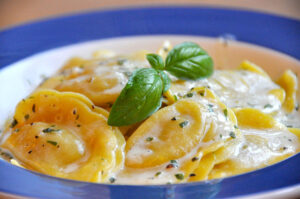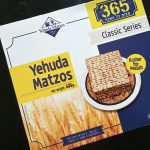The spirit of the Purim holiday (which is coming up next week), is one of near-reckless abandon, which shines through in the traditional Purim foods. This crazy-fun party holiday is one on which drinking is encouraged, even to excess (more on that in a future post), a festive meal is mandated, and gifts of food are traditionally exchanged between Jewish friends. But if I asked you to list traditional foods for the Purim holiday, you might be hard-pressed to come up with any beyond the now-ubiquitous hamantaschen cookies. Those of you who read my Purim post from last year, “No Virginia, Haman Did NOT Have Pointy Ears,” might be able to throw out the names of a few other, non-Ashkenazic pastries as well.
But there is another common and traditional Purim food that many of you might not be aware of. The holiday is one of three specific days in the year when it became common to eat kreplach — a homemade pasta dough folded around a chopped meat filling, and typically served in a soup. In fact, this is a tradition that (though kreplach are Ashkenazi) is followed by some non-Ashkenazi Jews as well.
So, how did they become a Purim food in the first place?
The Significance of the Purim Food
As with many Jewish food customs, particularly those that focus on symbolism, there is no definitive answer to the above question. (I have written previously about this issue a number of times.) Poke around enough and you’ll find a number of folk explanations, some of which overlap a bit, but none of which seem 100% accurate.
One of the key aspects in attempting to unravel this mystery is the three holidays on which it became customary to consume kreplach. In addition to Purim, the other days were just before Yom Kippur (at the meal immediately preceding the start of the fast) and Hoshanah Rabah, the 7th day of Sukkot, just before the Shmini Atzeret/Simchat Torah holiday. What do these three days have in common?
For starters, they are all somewhat festive days, and yet we are still allowed to do work on them (i.e. they are not like the Sabbath or the “major” festival days). So one explanation of the kreplach custom connects directly to this — we still want a fancier meal, including meat (seen as an elevated food), but that meat is wrapped or covered by dough to reflect the partial, or “covered” nature of this holiday.(1)Rite and Reason: 1050 Jewish Customs and Their Sources, Shmuel Pinchas Gelbard
A lovely explanation. But I’ve never heard these days referred to as “covered” holidays. So while conceptually this sort of works, it seems like a bit of a stretch to my mind. Furthermore, would there be anything wrong with consuming uncovered meat on these days? I think not.
A second option is that on all three of these holidays, man shloks — the Yiddish word meaning to beat. On the day before Yom Kippur, some have the custom to symbolically slaughter a chicken and give it to the poor, as a way of rectifying the stain of the sins previously committed. In this custom one is said to shlok kaparos. On Hoshanah Rabah, it is customary to beat willow branches on the ground (shlok hoshanos), also as a way of symbolically repenting and asking forgiveness. What was the shloking on Purim? The Jews beat the evil Haman!
Again, this seems farfetched. And as was humorously written in the classic 20th-century American-Jewish cookbook The Jewish Home Beautiful, “I have not been able to discover as yet why this toothsome delicacy [kreplach] was associated with shlogen which ordinarily, and when applied to Haman means to beat, but which has a somewhat different significance in the last two instances mentioned. Whatever the reason, as the tender kreplach slip into our mouths and we bite into their tasty fillings, we are grateful for the tradition.”(2)The Jewish Home Beautiful, Betty D. Greenberg and Althea O. Silverman
Finally, another explanation (albeit a vague one) focuses again on the wrapping aspect of the food, but further incorporates the ingredients themselves. The meat, which is red, is seen as reflecting the divine attribute of (at times harsh) justice, while the white noodles represent softer mercy.(3)The Jewish Kitchen: Recipes and Stories from Around the World, Clarissa Hyman The holiday at hand focuses on God’s mercy overriding his strict judgment, so kreplach become a logical Purim food to reflect this idea. Similarly, Yom Kippur and Hoshanah Rabah — just a week-and-a-half apart — connect to the season in which we are judged for the year ahead, so we eat kreplach as a hope that God will cover His harsh judgment with more peaceful mercy.
Still, this seems a bit forced in relation to Purim. Nothing within the holiday’s story suggests that the Jews were acting in a sinful manner, and thus deserving of harsh judgment. So why would we need to focus on the mercy-over-justice aspect here?
Not Just for Ashkenazim

Kreplach are essentially the same food as ravioli, of course. And one of the common foods eaten among Italian Jews on Purim is a spinach ravioli. Edda Servi Machlin guesses that this is simply because spinach was commonly in season at the time.(4)The Classic Cuisine of the Italian Jews I: Traditional Recipes and Menus and a Memoir of a Vanished way of Life, Edda Servi Machlin
The fact that a similar Purim food to kreplach is eaten in Italy, and yet it is not filled with meat, suggests a potential explanation. One aspect of Purim (that is not found on the other two holidays) is that the Jews were saved in a way that might not seem miraculous at all. As opposed to splitting a sea and visiting plagues upon our enemies, here the story is about God working subtly via humanity itself. (In fact, God does not even appear in the Book of Esther.) The event is referred to as a nes nistar, a “hidden miracle.” So perhaps kreplach were seen as hiding the “good stuff” inside of the everyday exterior. (The same might be said about hamantaschen as well, at least to a degree.)
And if so, the connections to Yom Kippur and Hoshanah Rabah may actually be coincidence more than anything else. In all of the explanations above, Purim was the holiday that was the outlier. Just as with many of the symbolic foods of Rosh Hashana, perhaps different connections brought the same food to be eaten on Purim and on Yom Kippur/Hoshanah Rabah.
Either way, we can enjoy this “toothsome delicacy” and just be “grateful for the tradition!”
Merry Purim everyone!
Footnotes
| ↑1 | Rite and Reason: 1050 Jewish Customs and Their Sources, Shmuel Pinchas Gelbard |
|---|---|
| ↑2 | The Jewish Home Beautiful, Betty D. Greenberg and Althea O. Silverman |
| ↑3 | The Jewish Kitchen: Recipes and Stories from Around the World, Clarissa Hyman |
| ↑4 | The Classic Cuisine of the Italian Jews I: Traditional Recipes and Menus and a Memoir of a Vanished way of Life, Edda Servi Machlin |






